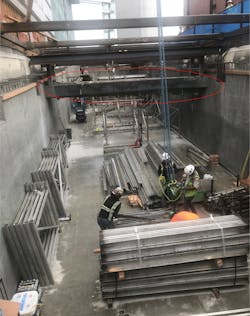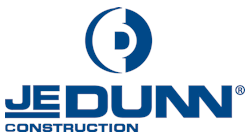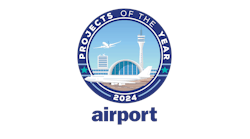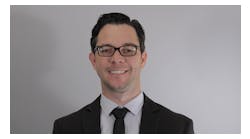Removing Risk for a Safe Site: Successful Prevention through Design at PDX Next
Safety is the top priority for every project. From assessing the site on the front end to implementing protocols throughout construction, to understanding how the end user will operate the building, safety is central to planning decisions made on each project. One method that is gaining traction and is seeing incredible results—both in safety and in user experience—is prevention through design (PtD). As the first phase in the $2.5 billion PDX Next project with the Port of Portland, the JE Dunn team was charged with facilitating and leading prevention through design for the 6-story parking garage and 5-story office building for rental car and airport operations, known as the Parking Additions and Consolidated Rental Car (PACR) project.
What Makes PtD Different?
Prevention through design is about more than safety; it’s about anticipating potential hazards to avoid both during construction and after the facility is turned over to the client, improving the experience of all from beginning to end. PtD begins as soon as design starts, so safety becomes integral to the design efforts and planning of the project. Too often safety hazards are addressed as an afterthought, when with a little forward thinking and commitment, we can avoid creating them altogether. PtD aims to reduce the creation of safety hazards from the start by getting the client, end users, design team, and contractor involved early, and creating a culture and mindset of Safety First in all situations. “Prevention through Design encompasses all of the efforts to anticipate and design out hazards to workers in facilities, work methods and operations, processes, equipment, tools, products, new technologies, and the organization of work,” said JE Dunn Project Manager Stacey Flint. “When done correctly, it can mitigate risk to constructability of Projects. PtD can also prevent upcoming clashes between trade partners, and end product users.”
Motivation for PtD
The biggest driver of PtD is control. The hierarchy of control chart illustrates the importance of engineering out hazards. Engineering out hazards reduces risk and injury to personnel and property, cost on safety training, planning, purchasing of personal protective equipment, eliminating the need for additional personnel and resources to mitigate the hazards.
Benefits of PtD
Many of the benefits such as improved safety, increased productivity, and higher quality are evident/obvious, but successful PtD helps project teams realize some peripheral advantages as well. These include fewer delays caused by accidents; enhanced designer-constructor collaboration; and reduced workers compensation claims due to less incidents. “These benefits are a result of simply mitigating risk,” said Flint. “For example, in lieu of putting regularly serviced equipment on a roof and then adding tie-offs for fall protection, teams should consider finding safe space on the ground for this equipment, effectively eliminating the potential for a fall altogether.”
In addition to the tangible benefits, PtD is advantageous when it comes to innovation and sustainable development. The increased collaboration between owner, designer, and contractor also enhances innovation to minimize safety risk in the building to the workforce while keeping things aesthetically pleasing and buildings functioning efficiently. When it comes to green building and sustainability, the National Institute for Occupational Safety and Health offers a LEED pilot credit for having a formal Prevention through Design Program to support and improve green construction. The program includes safety design review and constructability review of the building being built to ensure adherence, in turn resulting is a safer, more sustainable building.
The Case for PtD at Portland
The Port of Portland is extremely safety-focused, and partners with designers and general contractors who have this same focus. The team at PDX is actively dedicated to advancing safety in its active projects and in its existing facilities. The port included Prevention through Design requirements in the contract with JE Dunn. The Port did not have a Prevention through Design process for construction design build projects and wanted The PACR project to be the first of its kind at the PDX airport. The goal was to partner with JE Dunn and formalize a robust PtD package on the project. JE Dunn and port established a formal PtD committee consisting of the design team, construction superintendents, project managers, project engineers, safety professionals, and trade partners. While it takes all parties to be successful, the key to implementing PtD properly requires buy-in and leadership from superintendents. “Participation of the construction superintendents is critical for the process to work,” said Flint. “The superintendent is integral to scopes of work processes, scheduling, and potential impacts/clashes between trade partners. Without superintendent leadership in the meeting, it would be impossible to determine scope gaps, logistical challenges, sequencing, and structure of high-risk height work, steel erection, large excavation, utilities, traffic congestion, building skin and development.”
Getting Ahead of Safety
At its most basic level, the goal when implementing PtD is to identify where teams can bring the work to the worker rather than the other way around. By engineering hazards and potential issues of the facility itself before construction commences, the PDX Next improved overall safety from day one. These included:
· New Exit Toll Plaza serviceable equipment location (ground level)
o The original design of the Exit Toll Plaza would require maintenance workers to utilize fall arrest anchors and fall arrest gear to service the HVAC roof mounted unit. This included routine air filter changes. By placing the HVAC unit on the ground, all the servicing of the unit is now performed at ground working level, easing maintenance and eliminating fall exposure.
· RCC Building, serviceable roof antennas, addition of perimeter guardrail in lieu of tie-off points
o The design team anticipated the use of fall arrest anchors for the penthouse roof that would be accessed by maintenance workers on a routine basis. Fall arrest anchors is a common design for roofs, assuming the client finds it acceptable and safe. Working with the design team, the client communicated that the goal was “not to have workers in fall protection when performing a routine task, but rather eliminate the fall hazard altogether. In addition, an animated “drive-by” was created and it showed that the guardrail would not affect the aesthetics of the building design. Something as simple as a guardrail installed on the roof perimeter would ensure 100% safety from falls, so that was what was installed.
· Installing overhead ceiling light drivers at ground level location to reduce maintenance personnel from using scaffolds, lifts, etc. to reach heights.
o LED light technology is a great tool for both providing quality illumination and energy use reductions. The downside of LED lights is that they require a driver that converts the AC power into DC. LED lights will last years, but the drivers do not. When a driver needs replacement, if it is mounted in a high ceiling next to the LED light, maintenance workers must climb to a dangerous height—usually off ladders—to change the driver. By installing the driver at a working level, the risk of fall has been eliminated. Though a simple solution, it still requires client input in the design.
· Traffic control measures
o We used PtD to reroute traffic into the airport and around the construction site. We partnered with a traffic consultant and introduced “traffic calming” measures by adding additional signage, cross walks, and digital mph signs. We also had to keep the existing parking garages open 24 hours a day during drilling operations. The area we had to drill was directly under the FAA tower, and next to the central utility plant (CUP), which is essentially the “brains” of the airport. All data, water, and power communications is programmed and distributed from the central utility plant. We could not disturb or stop any operations in the CUP.
· Concrete beam in east pedestrian tunnel
o The concrete beam in the center of the picture (circled in red) below spans from wall to wall and is located in the east pedestrian tunnel. This picture is very important due to the concrete casing protecting the airport data lines that, if hit or disturbed, could shut down all data in the airport and all surrounding businesses. It was too great of a risk to reroute the line when installing the tunnel due to risk of shutting the port down. We encased the data lines in concrete and added structural supports to allow us to drill and work around the data line.
The Future of Prevention through Design
It is well noted that teams have an increased window to influence safety early in the project during planning and design. By taking advantage of the opportunity to bring together multiple stakeholders and increase collaboration, not only is safety enhanced, but design efficiency is also maximized. With the rise of Design-Build and CMGC style contracts across the industry, more and more people are seeing the benefit of bringing the contractor on earlier in the process, and the effectiveness and increased safety seen in PtD is one of those benefits.
John is a senior safety manager with JE Dunn Construction where he oversees safety for all projects in the Northwest. He holds a Bachelor’ degree in Environmental Health and Safety from Slippery Rock University of Pennsylvania and has been with JE Dunn for more than 13 years.
John demonstrates leadership and passion for safety by serving on various safety committees as well. John is well-known to his colleagues in the industry and is a current member of multiple construction groups including ASSE, Oregon Construction Safety Summit, WA/OR AGC, GPCP, and Oregon SHARP Alliance Committee.






